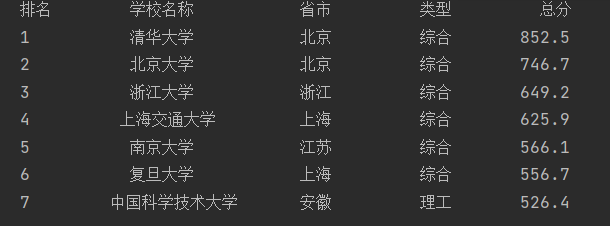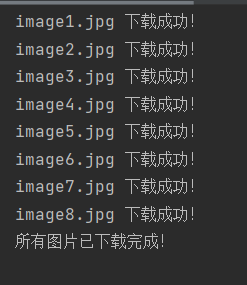2023数据采集与融合技术实践作业一
作业①
- 要求:用requests和BeautifulSoup库方法定向爬取给定网址(http://www.shanghairanking.cn/rankings/bcur/2020 )的数据,屏幕打印爬取的大学排名信息。
- 输出信息
| 排名 | 学校名称 | 省市 | 学校类型 | 总分 |
|---|---|---|---|---|
| 1 | 清华大学 | 北京 | 综合 | 852.5 |
| 2...... |
(1)代码
import urllib.request
from bs4 import BeautifulSoup
# 定义函数,获取指定url的HTML内容
def getHtml(url):
req = urllib.request.Request(url)
html = urllib.request.urlopen(req).read().decode()
return html
# 定义函数,对HTML内容进行解析,提取学校排名信息
def parseRankings(html):
soup = BeautifulSoup(html, "html.parser")
# 储存学校信息的列表
schools = []
for tr in soup.find('tbody').children:
r = tr.find_all("td")
temp = []
for i in range(5):
# 第二列是学校名称,所以特殊处理
if i == 1:
n = r[i].find("a").text.strip()
temp.append(n)
else:
temp.append(r[i].text.strip())
schools.append(temp)
return schools
# 定义函数,打印学校排名信息
def printSchoolList(schools, num):
tplt = "{0:^10}\t{1:^10}\t{2:^10}\t{3:^10}\t{4:^10}"
print(tplt.format("排名", "学校名称", "省市", "类型", "总分"))
# 打印指定数量的学校信息
for i in range(num):
school = schools[i]
print(tplt.format(school[0], school[1], school[2], school[3], school[4]))
# 主程序入口
if __name__ == '__main__':
url = "http://www.shanghairanking.cn/rankings/bcur/2020"
html = getHtml(url)
schools = parseRankings(html)
printSchoolList(schools, 7)
- 运行结果

(2)心得体会
该实验总体上不算很有难度,是通过F12查看需要爬取的元素信息,后较为中规中矩。反而在输出格式上花费了比较久的时间,因为学校名称长度差别较大,一开始的格式就较为长短不一,后对其进行居中处理,输出格式较为美观。通过本次实验,对request和bs4有了一定了解,自我有一定提升。
作业②
- 要求:用requests和re库方法设计某个商城(自已选择)商品比价定向爬虫,爬取该商城,以关键词“书包”搜索页面的数据,爬取商品名称和价格。
- 输出信息
| 序号 | 价格 | 商品名 |
|---|---|---|
| 1 | 65.00 | xxx |
| 2…… |
(1)代码:
import urllib.request
from bs4 import BeautifulSoup
import re
BASE_URL = "http://search.dangdang.com/?key=%E4%B9%A6%E5%8C%85&act=input"
def get_html(url):
#获取指定url的HTML内容
head = {
"User-Agent": "Mozilla/5.0 (Windows NT 10.0; WOW64) AppleWebKit/537.36 (KHTML, like Gecko) Chrome/70.0.3538.25 Safari/537.36 Core/1.70.3775.400 QQBrowser/10.6.4209.400"
}
request = urllib.request.Request(url, headers=head)
try:
response = urllib.request.urlopen(request)
return response.read().decode('gbk')
except urllib.error.URLError as e:
if hasattr(e, "code"):
print(e.code)
if hasattr(e, "reason"):
print(e.reason)
return None
def get_data_from_html(html):
#从HTML内容中提取商品名称和价格
soup = BeautifulSoup(html, "html.parser")
names = []
prices = []
for items in soup.find_all('p', attrs={"class": "name", "name": "title"}):
for name in items.find_all('a'):
title = name['title']
names.append(title)
for item in soup.find_all('span', attrs={"class": "price_n"}):
price = item.string
prices.append(price)
return names, prices
def print_goods_info(names, prices):
#打印商品名称和价格信息
print("序号\t\t\t", "价格\t\t\t", "商品名\t\t")
for i, (name, price) in enumerate(zip(names, prices)):
# 去除多余的空白字符
name = re.sub(r'\s+', ' ', name)
# 提取数字和小数点
price = re.findall(r'[\d.]+', price)
if price:
print(f"{i + 1}\t\t\t {price[0]}\t\t\t{name}")
def main():
names = []
prices = []
for i in range(1, 3): # 爬取1-2页的内容
url = BASE_URL + "&page_index=" + str(i)
html = get_html(url)
if html:
page_names, page_prices = get_data_from_html(html)
names.extend(page_names)
prices.extend(page_prices)
print_goods_info(names, prices)
if __name__ == "__main__":
main()
- 运行结果

(2)心得体会
本实验花费时间会相对多一些,一开始选定的是淘宝,但淘宝反爬机制较强,那时也没有想到转化为静态页面。故最后选择了当当网进行爬取。通过该实验,对F12的使用有了进一步的了解,通过F12来找到所需的元素。因为涉及一定翻页,故对其也进行了观察,发现了变化的元素,从而对代码进行修改。
作业③
- 要求:爬取一个给定网页( https://xcb.fzu.edu.cn/info/1071/4481.htm)或者自选网页的所有JPEG和JPG格式文件
- 输出信息:将自选网页内的所有JPEG和JPG文件保存在一个文件夹中
(1)代码:
import requests
import os
import re
def download_images():
# 创建存储图片的文件夹
image_dir = 'images'
if not os.path.exists(image_dir):
os.mkdir(image_dir)
url = 'https://xcb.fzu.edu.cn/info/1071/4481.htm'
headers = {
"User-Agent": "Mozilla/5.0 (Windows NT 10.0; Win64; x64) AppleWebKit/537.36 (KHTML, like Gecko) Chrome/117.0.0.0 Safari/537.36"
}
response = requests.get(url=url, headers=headers).text
# 使用正则表达式匹配图片链接
regex = r'src="(.*?\.(?:jpg|jpeg))"'
img_urls = re.findall(regex, response)
# 下载图片并保存到文件夹中
for index, img_url in enumerate(img_urls):
img_url_ = 'https://xcb.fzu.edu.cn{}'.format(img_url)
filename = f'image{index+1}.jpg' # 图片文件名
img_path = os.path.join(image_dir, filename) # 图片保存路径
response = requests.get(url=img_url_, headers=headers)
with open(img_path, 'wb') as f:
f.write(response.content)
print(f"{filename} 下载成功!")
print("所有图片已下载完成!")
if __name__ == "__main__":
download_images()
- 运行结果


(2)心得体会
该实验和前面的较为类似啦,即使用F12对所需元素进行查看,后使用正则表达式进行提取,本题将jpeg和jpg全都保存为jpg啦,处理较为简单,没有过多考虑如果是png等其他形态如何处理。


 浙公网安备 33010602011771号
浙公网安备 33010602011771号